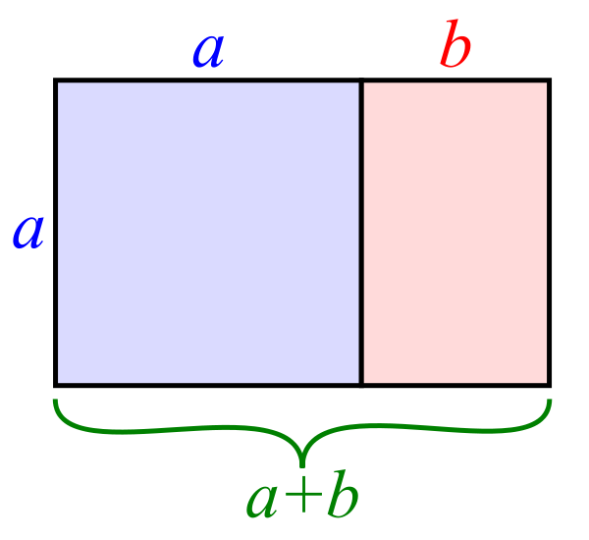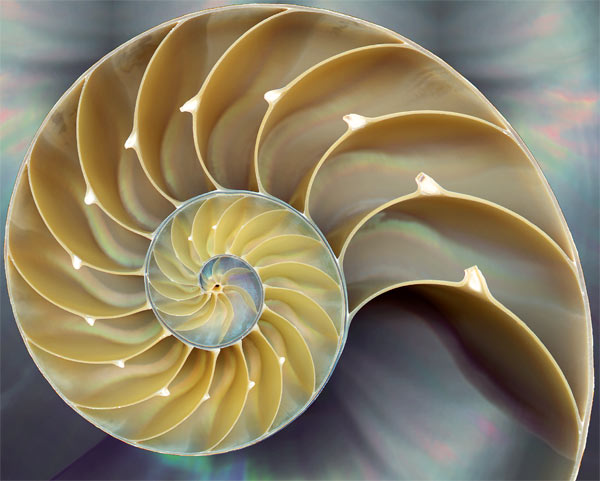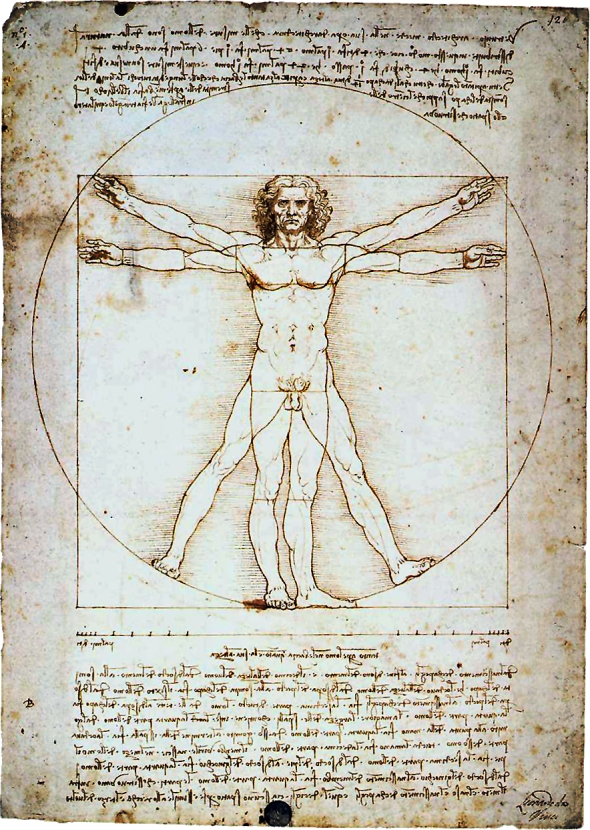Phi, or 1.618, is known as the golden ratio, and can be found throughout artistic composition and nature. It can be represented in the formula (a+b)/a = a/b = phi.This formula applies to the golden rectangle, shown below.
 According to Wikipedia, in 1854, Adolf Zeising researched and wrote about a universal law that connected the golden ratio to aesthetic value on a grand scale–from the build of the human body to the cosmos. Zeising “found the golden ratio expressed in the arrangement of branches along the stems of plants and of veins in leaves. He extended his research to the skeletons of animals and the branchings of their veins and nerves, to the proportions of chemical compounds and the geometry of crystals, even to the use of proportion in artistic endeavors” (Wikipedia, “Golden ratio”).
According to Wikipedia, in 1854, Adolf Zeising researched and wrote about a universal law that connected the golden ratio to aesthetic value on a grand scale–from the build of the human body to the cosmos. Zeising “found the golden ratio expressed in the arrangement of branches along the stems of plants and of veins in leaves. He extended his research to the skeletons of animals and the branchings of their veins and nerves, to the proportions of chemical compounds and the geometry of crystals, even to the use of proportion in artistic endeavors” (Wikipedia, “Golden ratio”).
The golden ratio is often associated with the Fibonacci sequence (0, 1, 1, 2, 3, 5, 8, 13, etc.) wherein any number in the sequence divided by its predecessor has an approximate value of 1.618. Moreover, each number in the sequence represents the sum of the two numbers that come before it. The Fibonacci sequence can then be used to graph an infinite logarithmic spiral based on units equated to each number in the sequence:
While scientists agree that logarithmic spirals, such as the one in the cactus featured below, are undoubtedly found throughout nature, debate still surrounds the exactness of these calculations due to variations among individual measurements.
 For example, the nautilus shell is often associated with the golden ratio and the Fibonacci spiral, but its logarithmic spiral does not always equal the exact proportions of the ratio, according to Wikipedia.
For example, the nautilus shell is often associated with the golden ratio and the Fibonacci spiral, but its logarithmic spiral does not always equal the exact proportions of the ratio, according to Wikipedia.
Long before Adolf Zeising’s research, artists and architects were applying the golden ratio to their work. For example, phi derives its name from Phidias, whom scholars believe employed the golden ratio when constructing the Parthenon in ancient Greece. Leonardo da Vinci and Luca Pacioli, who respectively illustrated and wrote De Divina Proportione (About the Divine Proportions), demonstrated the use of the golden ratio in mathematics and in relation to the human body.
Still today, the golden section rule is often applied to photographic composition as a means to create aesthetic value. It find it interesting that humans relate beauty to a ratio so inherent in not only the natural world but their own physical make-up. The golden ratio has even been applied to the human face, whereas facial proportions that measure the closest to the ratio are considered to be the most beautiful. The following photograph is just one of the many examples of how the golden ratio can be applied to photographic composition.
The photograph above also demonstrates how the golden section relates to other rules in composition, including the rule of thirds. If we divided the photograph into nine equal parts using four lines (two vertical and two horizontal), we would find that the points of interest lie where the lines connect. The water’s horizon cuts across the photograph at approximately one third of its height. The focal point, or the boat and sunset, lie at about one third from the right of the photograph, close to water’s horizon, naturally drawing the eye to that intersection.
While the rules in photographic composition are not set in stone, it is interesting that humans tend to share a collective vision of what proportions we find most aesthetically pleasing. This vision extends far beyond photography into other forms of art, beauty in nature, and even into the reflections in our own mirrors. Still, beauty is not dictated by a mathematical formula, and often, straying from it can have just as a profound effect on the viewer as operating within it.





That’s really awesome. I had never heard of the golden ratio before until my boyfriend heard about it. Apparently, some guy had a stroke and kept drawing it repeatedly, but didn’t know what he was drawing. This reminds me of the first class when we discussed the rule of thirds for pictures – something I had never known but made perfect sense to me once I heard it.
While I was reading this, I couldn’t help but think of a Criminal Minds episode in which Jason Alexander plays a serial killer whose actions are governed by his obsession with the Fibonacci sequence (the number of victims of each murder follows the sequence). Consequently, the locations of the murder follow the Fibonacci spiral as well. The analysts of the Behavioral Analysis Unit are able to find and save the last victims by following the spiral.
The episode is obviously a darker take on the Fibonacci sequence, but I have heard of people who have OCD and are driven by the sequence. This obsession is a little easier to understand after reading your post. Images that follow the Fibonacci spiral are more pleasing to the eye and seems to appear in nature. Those who have this obsession are more focused on the concepts we unconsciously accept.
I remember learning about the Fibonacci sequence in my seventh grade math class; it was the one and only time I actually enjoyed learned something math related lol. I think we had to do a project where we had to complete a set of equations and then map out the spiral they created. I’ve always been interested in the Fibonacci sequence, but I didn’t know that the golden ratio could be applied to human facial features; it reminds me of the opening of Scott McCloud’s lecture where he showed a series of objects that all looked like simple human faces (tub faucets, car tail lights, archways, etc.). We’re a very self-involved species, so I guess it makes sense that we would try to find beauty in ourselves via the golden ratio.